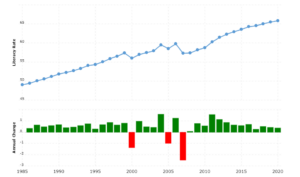At the dawn of independence in the 1950s and 60s, education was at the top of the list of development agendas for many newly-hatched African nations.
Leaders emphasized that education was the key to unlocking Africa’s political and economic development. Governments across the continent focused on building schools and encouraging parents to enroll their children. As a result, there was a rapid growth in certain aspects of education.
With access to primary education, literacy rates in the continent increased steadily over the years. Statistics show that in 1985, literacy rates in Sub-Saharan Africa stood at 49.6% —rising to 65.86% in 2020.

Literacy rates in Africa from 1985 to 2020
The Crisis in Africa’s Higher Education
Despite the successes recorded in primary education, access to higher education is still in crisis in Africa, especially Sub-Saharan Africa.
According to a report by Brookings, just 6% of children in Sub-Saharan Africa will enroll for higher education, a dismal figure compared to 80% of children in OECD countries.
In 2019, UNESCO statistics showed that the rate of enrollment to tertiary institutions in SSA stood at just over 9%—well below the global average of 32%.
However, it’s important to note that the statistics vary across the continent. For instance, while tertiary enrolment rates in Egypt stood at 33%, in Nigeria, Tanzania, and Niger it was 14%, 4%, and 2% respectively.
One of the main challenges facing access to higher education in Africa is the fact that the higher education institutions are too few for its booming youth population.
In an article published by University World News, Dr Kevin Andrews, the vice-chancellor of Unicaf University said that there was critical demand for higher education in Africa. “To meet that demand, Africa would need to build 10 universities a week, with each one of them enrolling 10,000 students every week for the next 12 years,” he said.
With only an estimated 1,650 institutions of higher learning in Africa, 740 of which are in ten of the continent’s ten most populous countries, university education remains an unattainable dream for many African students.
To clearly illustrate how dire the situation is, consider the fact that the measly number of higher education institutions in Africa serves a population of over 1.4 billion people.
Compare this to the US, which has around 5,300 universities and colleges serving a population of around 329 million people. The disparity is mind-blowing.
More African Students Choosing to Study Abroad
As the continent slowly works towards building its tertiary education capacity, one solution to this deficit is for African to pursue higher education abroad.
Until now, the region has had the most mobile students in the world. Approximately 5% of the total 8.1 million tertiary students from Sub-Saharan Africa pursue studies abroad at some point. In the rest of the world, only 2.4% of students study abroad.
Historically, France has been the most popular destination for Africans seeking education abroad. This can be attributed to the strong economic ties France has to its former colonies – especially in North and West Africa.
However, the preference for China as a study destination for African students has surpassed France. According to data from the Beijing-based consultancy Development Reimagined (DR), there were 74,011 African students in China in 2017 as opposed to 20,680 in 2011.
The US is the third most popular destination for African learners. In the 2019/2020 academic year, the number of Sub-Saharan students in the US hit a record high at 40,290 – a 2.1% increase over the previous year.
The numbers of African students are bound to increase exponentially in the coming decades, especially with the boom in the college-age population in the continent. With 19% of the global youth population (as of 2015), Africa is the world’s youngest continent. Almost 60% of Africa’s population is under the age of 25.
In the past global universities focused on attracting international students from Asia. As universities seek to diversify international student pipelines, experts expect to see more marketing efforts targeting African students.
International Education Provides a Competitive Edge
Other than the dismal number of institutions, another challenge undermining the pursuit of higher education in Africa is poverty. In Kenya for example, nearly half of households in the country earn less than $100 per month, with 2% having no income at all.
In the same country, the cost of acquiring a four-year undergraduate degree can be as high as $20,000.
Compounding the problem, investing in a degree from an African university doesn’t guarantee employment. Statistics show that nearly 50% of graduates from African universities struggle to find decent employment.
Data shows that getting more competitive degrees abroad can help African students save as much as $50,000. In addition, African students with degrees from foreign universities, especially in the West, have better employment prospects.
Enabling African Brilliance to Have a Global Impact
While Africa has a growing middle class, most African students desiring to pursue higher education abroad don’t have the funds to do so. Every year, more than 1.2 million African students receive offers from global universities. At best, due to lack of funding, only one third of those end up enrolling.
Available scholarships are far from meeting the demand for financial support for African learners. Without the required credit history, collateral, or co-signers, a majority of African student’s have also not been able to access international education loans.
In addition, many African students don’t have access to mentors who can guide them through the process of finding suitable universities abroad, applying for scholarships, and pursuing professional careers after graduation.
8B Education Investments was founded to bridge these gaps. We’re dedicated to lowering the barriers to access for African students, matching them with the financial, university, and employer networks they need to succeed.



